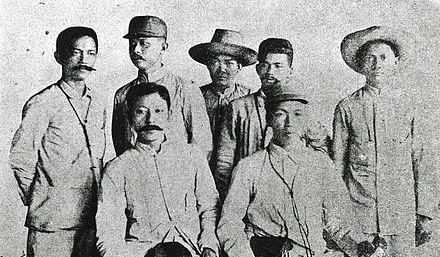Nueva Ecija
Nueva Ecija, officially the Province of Nueva Ecija (Tagalog: Lalawigan ng Nueva Ecija [ˈnwɛba ˈɛsiha], also [ˈnwɛva- ]; Ilocano: Probinsia ti Nueva Ecija), is a landlocked province in the Philippines located in the Central Luzon region. Its capital is the city of Palayan, while Cabanatuan, its former capital, is the largest local government unit (LGU). Nueva Ecija borders, from the south clockwise, Bulacan, Pampanga, Tarlac, Pangasinan, Nueva Vizcaya and Aurora. The province is nationally known as the Rice Granary of the Philippines, producing the largest rice yield in the country.
Nueva Ecija was named by the Spanish colonisers after the small town of Écija, Spain. Its indigenous names, such as Pinagpanaan, meaning the place where the arrow hit - defining the precolonial artistry in archery in the area, were abolished and changed by the government during the post-colonial period after World War II, sparking outrage from scholars and indigenous communities. Nevertheless, the name-change of some municipalities into colonial names during the post-colonial period was continued by the national government.
The sprawling and varied geological features of the land now known as Nueva Ecija, includes plains, mountains and rivers, all the requisites for the birth and sustenance of life itself. The land's very first settlers came upon three mountain ranges to the East, North and West and vast southern plains. All these were sustained by a great flowing river, one whose earliest name was spoken in a now lost tongue, and which was called the Rio Grande de Pampanga by the Spanish people later on. The Great Pampanga River nourished wild, fruit-bearing trees, served as home to an abundance of fish and made possible lush, teeming woodlands that sheltered animals.[6] All these combined must have been paradise in whatever language for the land's earliest settlers, who were able to not only survive but thrive in the surrounding abundance, all within easy reach.
These first settlers included tribes of Ilongots (Egungot) or Italons, Abaca and Buquids.[7] Settlements were built along the banks following the river's undulations. The Ilongots, meaning people of the forest, were the fierce headhunters and animist tribes who occupied Carranglan and the mountainous terrain of Sierra Madre and Caraballo.[8] The head hunting communities were nestled along the riverbanks of Rio Grande's tributaries in the north. Abaca and Italon were subgroups of Ilongots meaning river settlers. Ilongots survived mainly by fishing and hunting. Food production was a secondary occupation. The agriculture-based community of Caraclans and Buquids[9] were settled in Bongabon and Pantabangan along the riverbanks of Rio Grande's tributaries in the northeast.[10]
When the waves of Tagalog migrations took place between 300 and 200 B.C., intrepid travelers and traders set up settlements along Luzon's western coast. These early settlements formed the nucleus of the Pampango Empire that was consolidated by Balagtas. The flatlands of the southern portion of Upper Pampanga was a hospitable place for these new Tagalog settlers. The indigenous tribes were forced to take to the hills in the face of the Tagalogs' superior technology.[11]
Barter trade flourished among communities that settled along the great river. The constant riverside trading resulted in both a commercial and cultural exchange between the settlements in vast plains upstream of the Rio Grande de Pampanga. Settlements in Carranglan, Pantabangan, Bongabon and Puncan prospered and grew into more stable communities.



